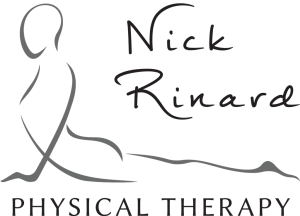 |
RinardPT
Monthly
|
Nick Rinard Physical Therapy
9700 SW Capitol Hwy Suite 140
Portland, OR 97219
Volume 7, Issue 1
January 2015
|
Megan is Now a MDT-Certified Physical Therapist!
|
|
We are so excited and proud that Megan’s hard work has paid off and she is now a certified MDT therapist, just like Nick!
The MDT certification is a LOT of work, requiring that several courses be taken and a thorough exam be completed in order to earn the honor of having ‘Cert. MDT’ after your name.
We hope you will join us in congratulating Megan on what has been a two-year effort for her! Those of you who have been helped by Megan know how knowledgeable she really is, and we thank you for spreading the word on how MDT at Nick Rinard PT helped you!
And in case you were wondering, she didn’t just pass the exam, she ACED IT!
|
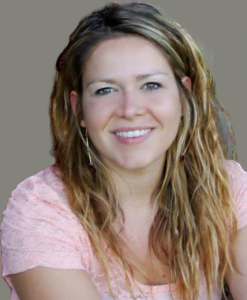
|
Nick Rinard Physical Therapy patients get Results:
Don’t just take our word for it
“I came in to Nick Rinard PT as a result of an MVA. I came in with neck and shoulder pain, headaches daily, decreased range of motion, and limited abilities at work and home.
After treatment the headaches are gone, range of motion is back and I am no longer limited in what I can do at home or at work.
The treatment was very simple and exercises were easy to do. I appreciate the Physical Therapists’ ability to translate the proper treatment into simple user-friendly exercises.”
-Andy 12/30/2014 |
“The treatment here was very effective. The staff and therapists work very well with one another and are consistent in case management. They were able to quickly identify my issue and moved toward resolution.”
-Lucas 12/10/2014 |
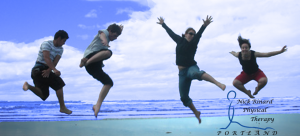
Phone: 503-244-6232 | Fax: 503-296-2305
help@mdtclinics.com | rinardpt.com
|
FREE CONSULTATION COUPON
MENTION THIS COUPON AND SCHEDULE YOUR FREE SCREEN TODAY
(503) 244-6232
In just 5-10 minutes, MDT can determine if your pain is mechanical or not. If so, we can help get you out of pain and back to enjoying your life. |
Happy New Year!

|
The beginning of a new year is so exciting! A fresh start with new goals and new beginning.
If you, like so many others, have made a resolution to get healthier this year, Nick Rinard PT may be able to help.
It is very difficult to stay active when you’re in pain!
Our MDT certified physical therapists can help keep you on track, and can teach you how to move to prevent injuries! Don’t allow pain to stand in the way of your goals!
|
Read all the Newsletters, helpful tips, reminders and more at :
http://RinardPT.com/clinical-conversations/
|
More
 |
RinardPT
Monthly
|
Nick Rinard Physical Therapy
9700 SW Capitol Hwy Suite 140
Portland, OR 97219
Volume 6, Issue 10
December 2014
|
HAPPY HOLIDAYS!
|

|
“Weather” you want to enjoy the winter activities by simply watching the snow fall or delve into it, be it skiing, sledding, snowboarding, or hiking to the top of the mountain in your snow shoes…
|
|
Nick Rinard PT is here for you!
|

|
|
Enjoy your favorite winter activities pain-free.
Have questions about form or returning to activity?
Nick Rinard PT is happy to answer your questions!
|

|
Nick Rinard Physical Therapy patients get Results:
Don’t just take our word for it
“After suffering from an auto accident 3 years ago, I have lived daily with chronic pain in my arm, shoulder, back, neck, chest and ribs, and suffered from daily headaches and weekly migraines. My range of motion in my neck was very restricted.
Since coming to Nick Rinard PT, Nick and Megan have not only helped me get the mobility to almost normal in my neck, but the pain is significantly reduced. They have given me tools to be productive and self-treat the pain. I feel they have increased my quality of life in managing my pain.. They deeply care about their patients and have a very friendly staff.”
-Denese11 11/19/2014 |
“I came to Nick Rinard PT because of pain in my knee that was limiting my ability to walk long distances of 3-4 miles or more. Because I enjoy walking my dogs & hiking in the woods, I need my knee to be functional! What was discovered in the process was that the problem was really my hamstring. Once Megan and Nick came up with exercises to target that area & strengthen it, I started to see improvements. Now I can walk farther with no pain!”
-Frances 11/20/2014 |

Phone: 503-244-6232 | Fax: 503-296-2305
help@mdtclinics.com | rinardpt.com
|
FREE CONSULTATION COUPON
MENTION THIS COUPON AND SCHEDULE YOUR FREE SCREEN TODAY
(503) 244-6232
In just 5-10 minutes, MDT can determine if your pain is mechanical or not. If so, we can help get you out of pain and back to enjoying your life. |
Thank YOU!
|
Dear Friends,
The holiday season is a great time to reflect on the past year. As we at Nick Rinard PT begin to prepare for another year of helping patients, we get to look back at all the wonderful people we have had the privilege of working with in 2014. Every time that we receive a patient’s hand-written results, it makes us so happy that we have been able to impact their lives. To be able to help someone like Denese (see other side), who has been in pain for 3 years, improve her quality of life truly makes our work meaningful.
Thank you for being a part of it, and for sharing your success stories with us and others who could use our help.
|
Read all the Newsletters, helpful tips, reminders and more at :
http://RinardPT.com/clinical-conversations/
|
More
 |
RinardPT
Monthly
|
Nick Rinard Physical Therapy
9700 SW Capitol Hwy Suite 140
Portland, OR 97219
Volume 6, Issue 9
November 2014
|
Are you putting off getting help?
|
|
With the end of the year quickly approaching, NOW may be the BEST time to get the treatment you need for your aches and pains!
With an average number of visits of just 6-8, you can likely complete treatment before the end of the year (when most insurance deductibles renew). |
Nick Rinard Physical Therapy patients get Results:
Don’t just take our word for it
“Thanks for the great care and customer service. It has been lovely working with the entire group. The McKenzie (MDT) method of PT was new to me. I was a bit skeptical as to the outcomes we could realize. But, after achieving the results I now have, I must admit that this type of PT has been a particularly positive experience for me. Since beginning treatment, I have less chronic back pain from my scoliosis, the exercises required have been easy to follow & execute, and for once I am looking forward to a stronger, more physically fit life. Previously, I was certain my chronic back pain caused in some part by scoliosis was only going to get worse and handicap me for the rest of my life. I am thrilled to find how wrong I was. I am sincerely appreciative.”
-Janelle 10/23/2014 |
“My family doctor sent me to Nick Rinard PT. I thought physical therapy was going to happen to me. Naps, massage, hot water, electrocution, and other pleasant things. I was surprised to find myself in mechanical diagnosis class. I learned a lot. Thank you!”
-Jeremy 10/17/2014 |

Phone: 503-244-6232 | Fax: 503-296-2305
help@mdtclinics.com | rinardpt.com
|
FREE CONSULTATION COUPON
MENTION THIS COUPON AND SCHEDULE YOUR FREE SCREEN TODAY
(503) 244-6232
In just 5-10 minutes, MDT can determine if your pain is mechanical or not. If so, we can help get you out of pain and back to enjoying your life. |
Happy Thanksgiving!
|
Nick Rinard Physical Therapy will be CLOSED for Thanksgiving on Thursday, November 27th 2014.
From everyone at Nick Rinard Physical Therapy, we wish you a Happy Thanksgiving surrounded by friends and loved ones.
|
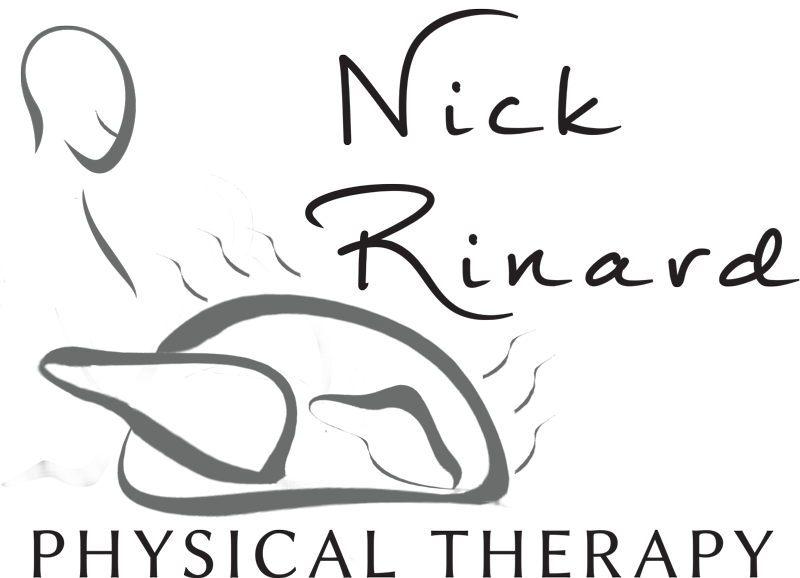
|
Read all the helpful tips and reminders at :
http://RinardPT.com/clinical-conversations/
|
More
 |
RinardPT
Monthly
|
Nick Rinard Physical Therapy
9700 SW Capitol Hwy Suite 140
Portland, OR 97219
Volume 6, Issue 8
October 2014
|
Pumpkin Carving Fun and Safety!
|
|
Who doesn’t love carving a pumpkin? Here are some tips to help you along :
- Don’t leave kids unattended! It doesn’t take long for an accident to occur.
- Use proper tools and never cut toward yourself or others.
- Carve the pumpkins before scooping them out. This will help prevent cuts caused by holding the pumpkin from the inside.
- Look for stencils! These pumpkins were carved by Maria and her boyfriend Jake using stencils so that even people who aren’t artists can be successful (Jake, who is an artist, took several hours to bring his Frankenstein to life!).
- If you have small children, consider painting pumpkins instead of carving! They can have fun with different colors, and you can relax knowing there are no sharp tools around.
|

Have a Safe and Happy Halloween
From All of us at Nick Rinard Physical Therapy
|
Nick Rinard Physical Therapy patients get Results:
Don’t just take our word for it
“When I entered therapy, I was suffering from constant headaches ranging from 3-6 out of 10 on the pain scale, as well as frequent dizziness. I also had decreased cognition. Through therapy and home exercises, my headaches and dizziness have entirely ended, and my cognition has greatly improved. I have much better posture and increased flexibility in my neck and shoulders.”
-Maya 09/08/2014 |
“I came in with extreme lower back pain and leg/foot numbness. I was told by Nick and Megan that I had a bulging disc. I had a less extreme occurrence prior and was misdiagnosed by another practitioner and was only given tools for pain management. Nick and Megan gave me a clear diagnosis, and clear plan, and the encouragement to complete my therapy. I am very satisfied with my treatment and would recommend Nick Rinard PT to anyone.”
-Darin 09/24/2014 |

Phone: 503-244-6232 | Fax: 503-296-2305
help@mdtclinics.com | rinardpt.com
|
FREE CONSULTATION COUPON
MENTION THIS COUPON AND SCHEDULE YOUR FREE SCREEN TODAY
(503) 244-6232
In just 5-10 minutes, MDT can determine if your pain is mechanical or not. If so, we can help get you out of pain and back to enjoying your life. |
Now a Preferred Provider with Regence Blue Cross Blue Shield
|
Nick Rinard Physical Therapy is now IN-NETWORK with Blue Cross Blue Shield!
We make every effort to make treatment affordable, and believe that we save patients time and money by providing our specialized care, regardless of insurance coverage.
Not sure of your physical therapy insurance coverage?
Nick Rinard PT checks insurance for ALL patients at no cost!
Call RinardPT today! 503-244-6232
|
 |
Read all the helpful tips and reminders at :
http://RinardPT.com/clinical-conversations/
|
More
 |
RinardPT Monthly
|
Nick Rinard Physical Therapy
9700 SW Capitol Hwy Suite 140
Portland, OR 97219
Volume 6, Issue 7
September 2014
|
Waiting to start PT after an accident can actually INCREASE your healing time
Some people are told to “rest” for 4-6 weeks before starting therapy after an accident. The problem with this? There are many things a person can do immediately after a car accident to facilitate healing and prevent dysfunction.
|
 |
All too often, we see people 6 months or more after a car accident (MVA). Without exercises at home, the picture is this: limited, painful movement of the spine or joint, global weakness, and poor posture that becomes painful when corrected.
The same is true for other types of trauma as well! Prolonged rest causes stiffness, and can lead to increased pain.
Nick Rinard Physical Therapy has a very effective treatment protocol that helps patients avoid loss in range in motion, and decrease pain!
Read more about this in our post “Why is it important to start therapy after a motor vehicle accident (MVA)“
Call today!
503-244-6232
RinardPT patients get Results:
Don’t just take our word for it
“I’ve had back pain for 3 years. My doctor and other physical therapists were unable to diagnose or treat the pain. Nick Rinard PT was able to give me exercises and treatments that have reduced the level of pain, and to make it go away following the exercises. Pain levels have gone from a level three (out of 10) to a one.”
-Gregg 08/20/2014 |
“I want to thank Ms. Megan Plante for turning my life around. When I can to your clinic suffering relentless pain and weakened from nerve trauma, and having experienced a severe drug reaction, I was not only in a state of withering health from these pathologies; I was also in a diminished mental state. Megan changed all that. With sincere dedication and intensive study and planning, she not only trained my body to a state of improved muscle function and control, she also gave me the encouragement I needed to achieve an improved mental outlook.
In short, Megan turned it all around to the point where my general health is now, in some ways, actually better than before the onset of this malady. I’ll always be grateful.”
-Terry 08/21/2014 |

Phone: 503-244-6232 | Fax: 503-296-2305
help@mdtclinics.com | rinardpt.com
|
FREE CONSULTATION COUPON
MENTION THIS COUPON AND SCHEDULE YOUR FREE SCREEN TODAY
(503) 244-6232
In just 5-10 minutes, MDT can determine if your pain is mechanical or not. If so, we can help get you out of pain and back to enjoying your life. |
Now a Preferred Provider with Regence Blue Cross Blue Shield
|
Nick Rinard Physical Therapy is now IN-NETWORK with Blue Cross Blue Shield!
We make every effort to make treatment affordable, and believe that we save patients time and money by providing our specialized care, regardless of insurance coverage.
Not sure of your physical therapy insurance coverage?
Nick Rinard PT checks insurance for ALL patients at no cost!
Call RinardPT today! 503-244-6232
|
 |
Read all the helpful tips and reminders at :
http://RinardPT.com/clinical-conversations/
|
More
 This is a question that seems to be in debate. At our clinic, we advise our patients to come in for treatment as soon as possible when experiencing pain in order for the fastest results. I have experienced push-back from other health care practioners who want the person to “rest” for 4-6 weeks before starting therapy. The problem with this? There are many things a person can be doing immediately after the MVA to facilitate healing and prevent dysfunction. All too often, we see people 6 months or longer after the MVA. If the patient has not been given anything to work on for exercises at home, the picture is this: limited, painful movement of the spine or joint, global weakness, and poor posture that becomes painful if corrected.
This is a question that seems to be in debate. At our clinic, we advise our patients to come in for treatment as soon as possible when experiencing pain in order for the fastest results. I have experienced push-back from other health care practioners who want the person to “rest” for 4-6 weeks before starting therapy. The problem with this? There are many things a person can be doing immediately after the MVA to facilitate healing and prevent dysfunction. All too often, we see people 6 months or longer after the MVA. If the patient has not been given anything to work on for exercises at home, the picture is this: limited, painful movement of the spine or joint, global weakness, and poor posture that becomes painful if corrected.
What does therapy look like in the first few weeks after an MVA?
- Initiate gentle range of motion exercise to prevent loss of movement
- Manual techniques including passive range of motion and soft tissue mobilization to promote blood flow and healing.
- Ultrasound modalities that decrease inflammation/swelling and promote tissue healing
- Education and training on how to prevent dysfunction
Here at Nick Rinard Physical Therapy, we see a lot of patients who have suffered an MVA. In fact, we see it so much we have a protocol for it that is very successful for treatment. Don’t wait! Start healing and feeling better today!
More
 |
RinardPT Monthly
|
Nick Rinard Physical Therapy
9700 SW Capitol Hwy Suite 140
Portland, OR 97219
Volume 6, Issue 6
August 2014
|
Now a Preferred Provider With
Regence Blue Cross Blue Shield!
Nick Rinard Physical Therapy is now IN-NETWORK with Blue Cross Blue Shield!
|
 |
We make every effort to make treatment affordable, and believe that we save patients time and money by providing our specialized care,
regardless of insurance coverage.
Not sure of your physical therapy insurance coverage?
Nick Rinard Physical Therapy checks insurance for ALL patients at no cost!
Call today!
503-244-6232
RinardPT patients get Results:
Don’t take our word for it
“After 1.5 years of caregiving for my sweet husband, I found my back was shot and motion difficult. You discovered that I was shifted to the left and not using my muscles symmetrically (what muscle I had, which wasn’t much!). The gradual prescription of more exercises for core strengthening (after correcting the shift) has been phenomenal. I am so glad to have my body working for me again, instead of yelling at me for living my life.”
-Shirley 07/29/2014 |
“I came to Nick Rinard PT with a chronic pain in my left shoulder area. I sit a lot: driving, computer work, TV, etc. I would go to the chiropractor one a month for relief, but the pain never went away. I finally went to my doctor who referred me to Nick. I was seen by Megan who spent a lot of time troubleshooting my pain. She came up with an exercise that gave me relief on the spot. I went home and performed the exercise several times per day. Within 3 days, the pain was completely gone! I went for one follow-up visit (only my 2nd visit) and was given instructions on how to incorporate the exercise as part of my ongoing therapy. This place is great!”
-James 07/07/2014 |
 |
FREE CONSULTATION COUPON
MENTION THIS COUPON AND SCHEDULE YOUR FREE SCREEN TODAY (503) 244-6232
In just 5-10 minutes, MDT can determine if your pain is mechanical or not. If so, we can help get you out of pain and back to enjoying your life.
|
How Important is Your Posture?
|
VERY IMPORTANT!
In fact, almost all of our patients are instructed in proper posture as a part of therapy.
Want to get the most mileage from your spine? Straighten up!
If you’re unable to sit up straight without pain, it’s time to give us a call.
|
 |
Read all the helpful tips and reminders at :
http://RinardPT.com/clinical-conversations/
|
More
Last week, I had a patient come into the clinic with neck pain that had started the week before. He had been a patient in the past and knew that the sooner he got in for treatment, the better.
Terry had pain medial to his left shoulder blade. This pain was limiting him with sleeping and with driving, as left rotation caused pain. He was rating his pain a 4/10 at the time of the evaluation.
Evaluation and Assessment
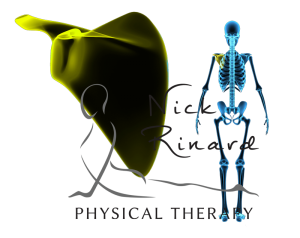
Scapula connects Upper Arm with Collar Bone
During the evaluation, left and right rotation motions produced pain medial to the left scapula. Upon palpation, the musculature where the pain was produced was very tender, acting like trigger points. I chose not to treat the trigger points, as these things are likely secondary to the real problem: a derangement.
During the repeated movement assessment, I had Terry go through retraction, extension and flexion. When we tested repeated left rotation, Terry’s pain decreased with repetition. Terry was sent home performing repeated left rotation with over-pressure. By his next visit, his pain was significantly decreased and the trigger points of the muscles had also decreased with pain when palpated. I had Terry increase the frequency of which he was to perform the rotation exercise. By the next visit, Terry had abolition of all pain, no limitation with sleeping or driving and the trigger points were completely gone!
Getting to the Root of the Problem
The Mechanical Diagnosis and Therapy (MDT) Method is very effective at getting to the root of the problem. When the core issue is fixed, the secondary impairments almost always resolve on their own. If a clinician is always treating the symptoms and not the cause, this will lead to more visits, more time until recovery and more money from the patient. This is one of the fundamental reasons that we practice the MDT Method here at Nick Rinard Physical Therapy – to fix your core issues!
More
 |
RinardPT Monthly
|
Nick Rinard Physical Therapy
9700 SW Capitol Hwy Suite 140
Portland, OR 97219
Volume 6, Issue 5
July 2014
|
We Appreciate YOU!
Did you know that you help make up 40% of the patients we see? Yes, YOU!
40% of the patients we treat are past patients returning for a different issue, or patients referred to Nick Rinard Physical Therapy by a past patient.
|
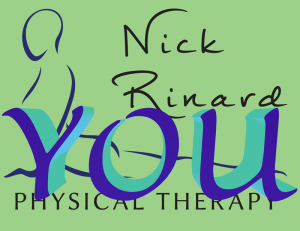 |
We want you to know that we appreciate you, and that despite all the changes that have happened to healthcare (and those to come) YOU are still still our first priority. We are committed to your PT being as effective as possible, and are still working hard to get you better in an average of 6-8 visits!
Call 503-244-6232
for your Evaluation or Free Consultation
RinardPT patients get Results:
Don’t take our word for it
“I came to Nick Rinard Physical Therapy hoping to find relief from debilitating neck pain-24/7-which had mysteriously begun about 2 weeks prior to my first visit. My husband had been treated here a few years ago-also for neck problems.
Within a few sessions my range of motion, with little to no pain, had improved tremendously! In addition, I was given specific ‘exercises’ I can easily do on my own to further improve movement, and to hopefully prevent the neck problem from happening again. Thank you!”
-Doris 06/24/2014 (5 visits total) |
“I had severe neck pain and limited movement of my head-both up and down, and left to right.
The pain has now been almost completely taken care of and normal motion has returned. The exercises given have really helped.”
-James 06/03/2014 (6 visits total) |
 |
FREE CONSULTATION COUPON
MENTION THIS COUPON AND SCHEDULE YOUR FREE SCREEN TODAY (503) 244-6232
In just 5-10 minutes, MDT can determine if your pain is mechanical or not. If so, we can help get you out of pain and back to enjoying your life.
|
Clinical Conversations NOW at RinardPT.com
|
More
‘R.I.C.E.’ Coined in 1978
‘R.I.C.E.’ (rest, ice, compression, elevation) was coined in 1978 by Dr. Gabe Mirkin. Since then, ice has been the standard treatment for injuries and sore muscles. The RICE guidelines have been used for decades, but it now appears that ice and rest may delay healing.
Scientific Articles Don’t Support Ice for Healing
 A study from The American Journal of Sports Medicine, June 2013 asked athletes to exercise intensely enough to develop muscle damage that caused extensive muscle soreness. It was found that icing delayed swelling, but did not quicken the healing process. A summary of 22 scientific articles found little to no evidence supporting that ice and compression facilitate healing over compression alone.
A study from The American Journal of Sports Medicine, June 2013 asked athletes to exercise intensely enough to develop muscle damage that caused extensive muscle soreness. It was found that icing delayed swelling, but did not quicken the healing process. A summary of 22 scientific articles found little to no evidence supporting that ice and compression facilitate healing over compression alone.
Inflammation
Inflammation is required for healing. Inflammation is a part of our immune system and is essential in the healing process. Inflammatory cells migrate to the injured tissue to start the healing process. Macrophages (inflammatory cells) release a hormone into injured tissues, which helps muscles and other injured tissues heal. Applying ice to reduce swelling can delay healing by preventing the body from releasing this hormone.
Icing can also prevent healing cells from entering the injured tissues by constricting blood-flow. It can take hours for the blood vessels to return to their size. Icing can also decrease strength, speed, endurance and coordination.
General Tips for Using Ice
If you’re going to ice, only apply ice for 10-15 minutes at a time. Utilize ice for the first day of injury. Seek medical attention from a mechanical physical therapist if the pain is severe or you cannot actively move a body part.
More
 (formerly Mechanical Diagnosis and Therapy of Portland, PC)
(formerly Mechanical Diagnosis and Therapy of Portland, PC)
 This is a question that seems to be in debate. At our clinic, we advise our patients to come in for treatment as soon as possible when experiencing pain in order for the fastest results. I have experienced push-back from other health care practioners who want the person to “rest” for 4-6 weeks before starting therapy. The problem with this? There are many things a person can be doing immediately after the MVA to facilitate healing and prevent dysfunction. All too often, we see people 6 months or longer after the MVA. If the patient has not been given anything to work on for exercises at home, the picture is this: limited, painful movement of the spine or joint, global weakness, and poor posture that becomes painful if corrected.
This is a question that seems to be in debate. At our clinic, we advise our patients to come in for treatment as soon as possible when experiencing pain in order for the fastest results. I have experienced push-back from other health care practioners who want the person to “rest” for 4-6 weeks before starting therapy. The problem with this? There are many things a person can be doing immediately after the MVA to facilitate healing and prevent dysfunction. All too often, we see people 6 months or longer after the MVA. If the patient has not been given anything to work on for exercises at home, the picture is this: limited, painful movement of the spine or joint, global weakness, and poor posture that becomes painful if corrected. A study from The American Journal of Sports Medicine, June 2013 asked athletes to exercise intensely enough to develop muscle damage that caused extensive muscle soreness. It was found that icing delayed swelling, but did not quicken the healing process. A summary of 22 scientific articles found little to no evidence supporting that ice and compression facilitate healing over compression alone.
A study from The American Journal of Sports Medicine, June 2013 asked athletes to exercise intensely enough to develop muscle damage that caused extensive muscle soreness. It was found that icing delayed swelling, but did not quicken the healing process. A summary of 22 scientific articles found little to no evidence supporting that ice and compression facilitate healing over compression alone.